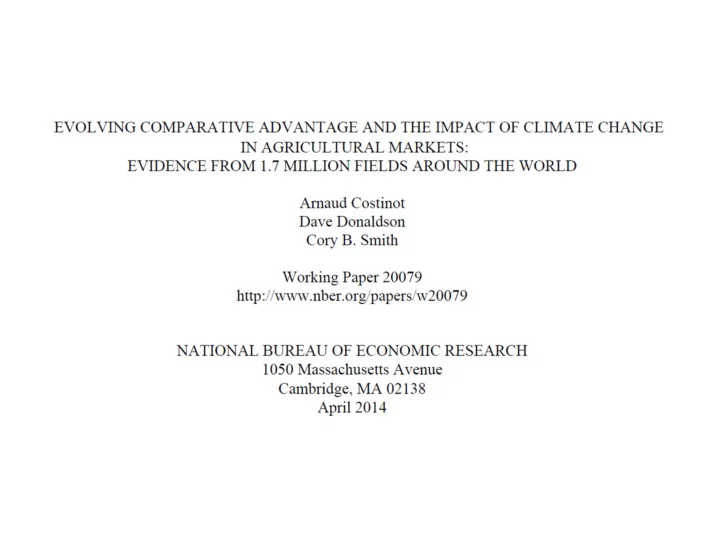

EVOLVING COMPARATIVE ADVANTAGE AND THE IMPACT OF CLIMATE CHANGE IN AGRICULTURAL MARKETS: EVIDENCE FROM 1.7 MILLION FIELDS AROUND THE WORLD Arnaud Costinot Dave Donaldson Cory B. Smith April 2014 Presented by: Iman Haqiqi
Abstract A large agronomic literature models the implications of climate • change for a variety of crops and locations around the world. The goal of the present paper is to quantify the macro-level • consequences of these micro-level shocks. Using an extremely rich micro-level dataset that contains • information about the productivity---both before and after climate change---of each of 10 crops for each of 1.7 million fields covering the surface of the Earth, we find that the impact of climate change on these agricultural • markets would amount to a 0.26% reduction in global GDP when trade and production patterns are allowed to adjust.
Adaptation • The warmer climates predicted a grim future for agricultural plant life on which human welfare depends. • climate change has a differential effect on crop yields both within and between countries, • then adjustments through production and trade patterns may significantly dampen the adverse consequences of climate change • a country may stop producing a crop whose yields have fallen and import it in exchange for another crop whose yields have remained constant at home.
Quesions • ( i ) where crops are produced and, in turn, which productivity changes are relevant and which ones are not; • ( ii ) how shocks to the supply of crops affect prices around the world; and • ( iii ) how changes in productivity and prices map into consumption and welfare changes.
• the quantitative predictions of our model depend • on three key elasticities: • ( i ) the elasticity of substitution between different varieties of the same crop; • ( ii ) the elasticity of substitution between different crops; and • ( iii ) the extent of within-field heterogeneity in productivity, which is unobserved in the GAEZ data.
MODEL
Preferences
Production
Trade
Optimal Land Use
DATA
GAEZ • extremely rich micro-level dataset on agricultural productivity: • the Food and Agriculture Organization’s (FAO) Global Agro- Ecological Zones (GAEZ) dataset. • high resolution data on geographic characteristics such as soil, topography, elevation and, crucially, climatic conditions • To predict the yield that would be obtainable—crop by crop—at 1.7 million high resolution grid cells covering the surface of the Earth • Within-country heterogeneity is a central feature of these data
• The primary goal of the GAEZ project is to inform farmers and government agencies about optimal crop choice in any given location on Earth—that is, to help farmers to know how productive they would be at crops they are not currently growing.
Pre-Climate Change eight different soil types and conditions, elevation, average land gradient, • and climatic variables such as rainfall, temperature, humidity, wind speed and sun exposure. Importantly, GAEZ handles climate conditions particularly carefully. For a • given year, data on the stream of daily weather is used to predict how well a crop will fare as each date progresses. We use GAEZ output from what the GAEZ project refers to as the • “baseline” period, an average of runs of the GAEZ models for the daily weather records observed in each year from 1961 to 1990. Naturally, farmers’ decisions about how to grow their crops and what • complementary inputs to apply affect crop yields in addition to the land characteristics, such as sunlight exposure, over which farmers have relatively little control. => “high inputs” scenario
climatic data is available • at the 5 arc-minute level At the 5 arc-minute level • there are around 9 million grid cells the 50 most • agriculturally important countries, we are left with 1,683,193 grid cells World Borders Dataset •
Post-Climate Change post-climate change estimates are based on an average of runs of • the GAEZ models over a 30-year period, only instead of realized past weather the GAEZ project uses the predicted future daily stream of weather from 2071 to 2100. Estimates of future daily weather series are themselves obtained • from an average of runs of a General Circulation Model (GCM) under a particular Special Report on Emission Scenarios (SRES) from the IPCC programme. The IPCC programme comprises a total of 23 GCM and 40 SRES . • Each SRES corresponds to a different “narrative storyline” about the potential evolution of various demographic, social, economic, technological, and environment variables.
Agricultural Output, Land Use, Price, and Trade Flow Data
ESTIMATION
Endogeneity
GOODNESS OF FIT
• Here, we report several moments-related to output, land use, and trade flows—as generated by the model at the previously estimated parameters and compare them to the same moments in the data .
SIMULATIONS
A Simple Calculation
SENSITIVITY ANALYSIS
Thanks
Recommend
More recommend